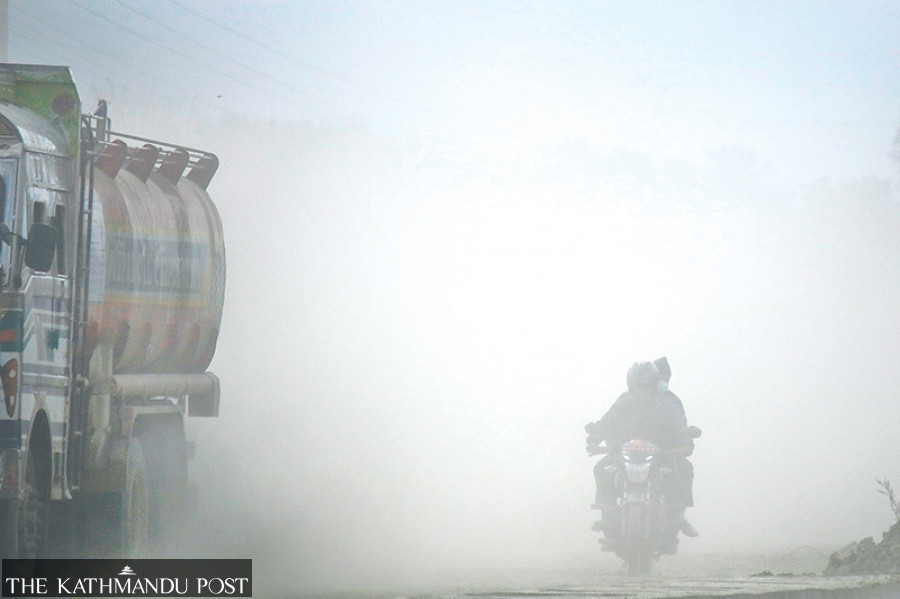Kathmandu
Kathmandu Metropolitan City to crack down on polluting vehicles
Officials say they will soon start random emission testing on the road in coordination with traffic police and the environment department.
Post Report
As the Kathmandu Valley’s air quality is set to deteriorate in the coming days, the Kathmandu Metropolitan City is gearing up to start vehicle emission testing.
For this, the city office has purchased a smoke meter (a portable device for testing vehicle emissions), which will be used in coordination with other stakeholders—the Metropolitan Traffic Police Division, the Department of Transport Management, and the Department of Environment.
“Vehicle emission testing is mainly the responsibility of the agencies under the federal government, but the constitution has also given local governments the authority to take measures to reduce pollution,” said Sarita Rai, chief of the Environment Department. “We also have developed pollution control guidelines as per the KMC Environment and Natural Resources Protection Act-2021.”
Officials say vehicle emission testing will start once the pollution control guidelines are published in the metropolis gazette. In the first phase, emissions of petrol and diesel vehicles operating in the metropolis will be randomly tested, and the city office has also planned to carry out emission testing for motorcycles.
Emission testing will be carried out on vehicles that have passed emission testing from the Department of Transport Management and received green stickers.
Officials say that vehicles with green stickers could still emit black smoke for various reasons, including lack of timely servicing and maintenance.
“We have seen many vehicles with green stickers emitting black smoke,” an official at the Environment Department of the KMC said, asking not to be named as the official is not authorised to talk to the media. “Many automobile owners only service their vehicles ahead of the annual pollution testing.”
Officials say that the amount of the fine will be determined based on the suggestions of stakeholders.
Vehicle emission testing is among the measures the city office has been taking to reduce pollution levels in the metropolis.
The KMC has also started independently monitoring the city's air quality, with support from the Partnership for Healthy Cities, which has provided 19 portable devices to the city office.
The Partnership for Healthy Cities is a global network of 74 cities, including the Kathmandu metropolis, committed to saving lives by preventing noncommunicable diseases and injuries. The programme is supported by Bloomberg Philanthropies in partnership with the World Health Organisation and Vital Strategies.
Nepal’s air quality reaches hazardous levels several times a year during winter and summer, and the capital city often ranks as the world’s most polluted metropolis.
Major hospitals also report a spike in respiratory problems due to the impact of toxic air and dust. Doctors warn that people get sick from respiratory illnesses caused by polluted air throughout the year, due to polluted air.
Doctors say air pollution is known to cause various respiratory illnesses. Poor air quality can cause short- and long-term effects on public health. In the short term, it can lead to pneumonia, bronchitis, conjunctivitis, skin allergy, stroke, and heart problems, and in the long run it can lead to severe conditions like ulcers, and cancer of the lungs and intestine, kidney disease, and heart complications.
People in low- and middle-income countries get disproportionately affected by the polluted air, which accounts for more than 90 percent of deaths, according to the World Health Organisation.
Several studies carried out in the past in Nepal show that toxic air takes a huge toll on public health. Along with respiratory illness, the toxic air has led to severe conditions like ulcers, cancer of the lungs and intestine, kidney disease, heart complications, high blood pressure and stroke, according to experts.
The report, titled “Global burden and strength of evidence for 88 risk factors in 204 countries and 811 subnational locations, 1990–2021: A systematic analysis for the global burden of disease study 2021,” finds that air pollution was the leading contributor to the global disease burden in 2021, making for eight percent of total disability-adjusted life years (DALYs), followed by high blood pressure (7.8 percent). The report was published in The Lancet, a leading international medical journal.
Studies carried out in the past show that polluted air has been shortening people’s lives. Nepali lives are being cut short by around five years, according to a report by the Air Quality Life Index (AQLI), which converts air pollution concentration into an impact on life expectancy. AQLI is a metric produced by the Energy Policy Institute at the University of Chicago.
Toxic air is deadlier than tobacco use and high blood pressure, which reduce life by 2.8 years and 1.7 years, respectively, according to the report.
Environment experts in Nepal often point out that worsening air quality has not only affected people’s health but also hit the economy and hindered overall development of the country.




 10.12°C Kathmandu
10.12°C Kathmandu










